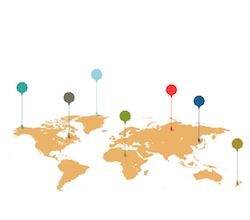

One of the most frequent questions I get asked by healthcare professionals who see the value in social media, but who haven’t yet taken the plunge, is: “How do I find the time to post regular updates?” It’s an important question, for if you want your healthcare social media marketing to be effective, you will need to maintain a consistent presence online. One solution is to schedule your healthcare news to reach your audience – even when you are not online. It sounds like a simple solution, and in many ways it is. But there is also an art and a science to online scheduling, which I want to teach you today. Master it and you will make more efficient use of your time online while increasing the spread of your healthcare messages.
But first, let’s clear up a misunderstanding on the difference between scheduled and automated tweets. It is the latter that has garnered the most criticism – and with good reason.
Scheduled tweets are created by you, and scheduled to be shared at a specific time or specific intervals determined by you. Automated tweets are created and scheduled by a web app which scans Twitter looking for particular keywords, and then automatically shares articles and websites containing those keywords. Another type of automation is sending a direct message (DM) to a user when they follow an account. It is usually percevied as spam, since it most freqeuntly pitches a product or service or tries to tempt you with a free download as a way of getting you to join a mailing list.
So let’s move on to a closer look at the ways in which scheduling your tweets can be of benefit to your healthcare social media marketing.
6 Reasons You Should Schedule Your Healthcare Tweets
1. Drive more traffic to your website or blog
If you wish to share a new piece of content on your healthcare website or blog you can tweet a link to the site’s url. It makes sense that the more times you share this link, the more people will see it and visit your site. The best way to do this is to spread out at intervals the number of times you share the original link. This way you’ll be able to reach more people who might have otherwise missed out on seeing your content the first time around.
2. Hit multiple time zones
The internet is global and if you want the spread of your content to reach further than your own backyard, you need to hit multiple time zones. Scheduling your healthcare tweets allows you to reach followers when they are most likely to be online (even if you aren’t there at the same time) and allows you to maintain a regular and consistent online global presence.
3. Reach new followers
If you provide valuable healthcare content for your readers there is a good chance that you are attracting new followers every day. They may have missed out on something you shared last month (or even six months ago); by scheduling a tweet linking to an old post they will be picking up on it for the first time and finding it of fresh interest.
4. Make more efficient use of your time online
You are a busy healthcare professional and finding the time to go online can be an issue. By scheduling your social media updates you can make more efficient use of your time. You can set aside a specific time each day for creating your social media updates. This needn’t take more than 10 minutes each day. If during the day you come across a new article, video or other healthcare content which you’d like to share you can simply add it to your online scheduler.
5. Avoid flooding your Twitter timeline
If like me you do a lot of catching up on blogs and other online content first thing in the morning, it is easy to flood your Twitter timeline by sharing links to articles and posts. Using a scheduling tool you can provide a steady trickle of valuable tweets throughout the day, rather than deluging your followers with a downpour all at the same time – a sure-fire way to lose followers.
6. Social media marketing intelligence
Scheduling your content is a great way to find what your audience is most interested in. By using a scheduling app (see list below) you will quickly and easily find out which health content attracts the most interest (and which doesn’t) and you can adapt your healthcare marketing to reflect this.
When To Schedule
Dan Zarella has researched the science of timing your social media updates, reporting that late in the day and week you will get the most retweets; weekends are best for Facebook updates, and early morning is best for blog links. While these findings are a useful starting point, you should really test this for yourself and determine what works best for your specific audience. Try scheduling your updates to reflect Zarella’s findings to find your own tweeting sweet spot (and don’t forget the different time zones of your global health audience).
When NOT To Schedule
1. Breaking news on Twitter
Opponents of scheduling argue that it can at best make you appear lazy and inauthentic, and at worst leave you with egg on your face if your scheduled tweet pops up at a time of breaking news. In an infamous case, an events promotions company who sent out a scheduled tweet during a Radiohead gig asking fans to tweet pictures live from the event, did so just as the concert had been cancelled because the stage collapsed during set-up, leaving at least one person dead. The tweet left the company looking crass and insensitive. Imprint this example on your mind right now. Next time a live event or breaking news story appears on Twitter, you will know what to do – head straight to your tweet scheduler and remove your scheduled tweets.
2. Synching your Twitter and Facebook updates
Not strictly a scheduling issue, but worth noting here. I advise against automatically tweeting your Facebook updates to your Twitter account (and vice versa). Each of these platforms has its own function, design, audience, and language, and cross-posting in this way simply doesn’t work. The most obvious indicator is that your Facebook update is usually longer than Twitter’s 140 characters, so when it appears on your Twitter timeline it is truncated and makes no sense. And the abbreviated language of Twitter, for instance RT, just doesn’t make sense in the Facebook context. That is not to say that the healthcare content you post won’t work in both places, but that you need to modify how you present it.
How To Get Scheduling Right
Bearing the aforementioned provisos in mind here are my three golden rules for scheduling your healthcare tweets.
Rule #1 Vary Your Updates
Vary the tweet so you are not repeating it verbatim each time. You could try reframing your original tweet as a question, or a statement, tweet a key statistic or highlight different elements of the content each time you re-tweet it. Another advantage of reframing your content in this way, is that you get to see which types of headlines work best – this can be a great guide to your future content creation efforts. If you see a significant difference in headline engagement, you could even go back to your original post and change the title to reflect this (the url remains unaffected).
Rule #2 Keep It Real
The criticism of scheduling as being too impersonal has some merit if you only schedule tweets and never engage with your Twitter followers. You want to make sure you maintain a good balance between scheduling and genuine interaction. Choose a morning and evening time when you will check your timeline to engage with conversations, retweet good content and respond to any interaction on your timeline. Never let scheduling take over from real engagement.
Rule #3 Pause For Thought
Pause before you schedule your tweet and ask yourself if it is of value to your audience. If it is a self-congratulatory tweet or an obvious sales pitch, then please don’t post it. If it is a video, or a blog post, or any other content which contains information your followers will find of value, then by all means, tweet, tweet and tweet again.
So, now you know the why of scheduling, next up the how. Here are some tools I recommend for the job.
Recommended Scheduling Tools
Since the option to schedule tweets doesn’t actually exist on Twitter, you need to choose a third-party app to do the job. There are many tools available for scheduling tweets – both paid and free. Paid apps provide extra functionality and analytics which is useful for marketers. The tools which I list below have both paid and free options available.
1. Buffer
 This is my favorite scheduling app. It’s free to schedule up to ten tweets at once and provides basic analytics so you can quickly see which of your tweets perform the best with its “top post” icon. You can also choose to connect your Facebook, Google+ and LinkedIn accounts (but remember my advice about synching your platforms). In addition you can combine your Buffer account with Feedly, a popular news aggregator application. This allows you to add what you’re reading to your Buffer without opening a new app or browser window. Buffer also makes it easy to retweet your favorite followers’ tweets. Simply add the retweets to your Buffer account as you catch up on Twitter so your tweets get spaced out for you.
This is my favorite scheduling app. It’s free to schedule up to ten tweets at once and provides basic analytics so you can quickly see which of your tweets perform the best with its “top post” icon. You can also choose to connect your Facebook, Google+ and LinkedIn accounts (but remember my advice about synching your platforms). In addition you can combine your Buffer account with Feedly, a popular news aggregator application. This allows you to add what you’re reading to your Buffer without opening a new app or browser window. Buffer also makes it easy to retweet your favorite followers’ tweets. Simply add the retweets to your Buffer account as you catch up on Twitter so your tweets get spaced out for you.
2. SocialOomph

Another tool I recommend. One of the nice features of SocialOomph is its start-up guide for new users which makes the learning curve much easier. Among its free features you can monitor breaking news and other interests and choose to receive a tweet digest email which monitors keywords in your industry. It can also be integrated with bitly, a popular URL shortening and bookmarking service which can help you both track and keep track of your links
A recent change to SocialOomph’s queue reservoir feature now enables you to
- Specify a specific date and time at which the queue must be paused (stop publishing updates), which is ideal for a time-limited campaign.
- Specify a specific date and time at which we must delete from Twitter and Facebook all updates that the queue published to those social networks, which is ideal to automatically remove outdated and potentially confusing information from your Twitter and Facebook streams.
3. Hootsuite

I use Hootsuite as my multi-account, multi-network Twitter client so it makes sense for me to schedule tweets from within it. You can also schedule updates to your Facebook account from here (but only do so with caution – see my advice above).
4. Tweetdeck
Another Twitter dashboard which allows you to schedule your tweets. You can also authorize TweetDeck to use your bitly credentials so you get personalized link data.

The next two apps are very simple to use and require no registration. If you just want to try out scheduling your updates, you could give one of these a try. If you are looking for analytics try one of the clients above, as these don’t provide any analytics.
5. Twuffer
Twuffer stands for Twitter Buffer and it is an application built specifically for tweet scheduling. You sign in instantly with your Twitter account (no registration required) select your time zone, and choose whether you want your tweets to be included on the Twuffer home page for added exposure.
6. LaterBro
Another simple to use tool, with no registration requirement. Simply sign in with your Twitter of Facebook account, choose your time zone , schedule your tweet and time and you are all set.
Conclusion
When done the correct way, scheduling your tweets allows you to invest a shorter period of time to gain more results. But always remember that the most effective healthcare social media strategy is personal and direct engagment with your audience. Make sure you always weigh the balance in favor of being a real person and not an automaton. It is genuine engagment which builds trust and credibility in your brand and cements strong, lasting relationships.
Do you schedule your social media updates? Which tools would you recommend for the job?
Logo by Marie Otskua






